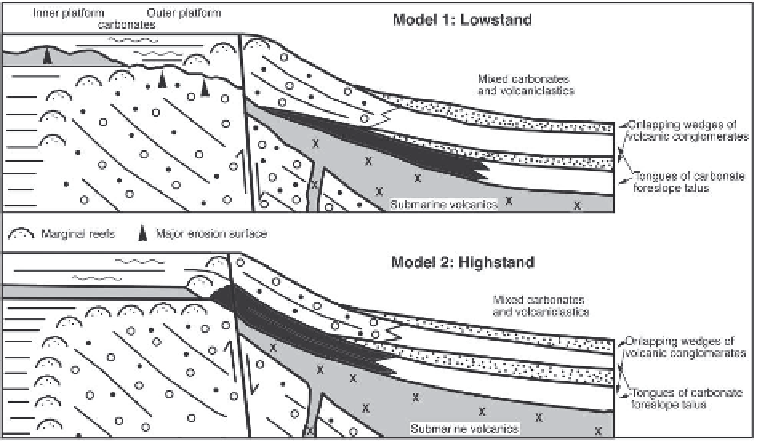Geology Reference
In-Depth Information
Plate 115 Standard Microfacies Types: SMF 5 and SMF 6
SMF 5.
For a general explanation of SMF 5, see Pl. 114.
SMF 6. Densely packed reef rudstone
Criteria:
Coarse gravels of biogenic material and lithified sediment derived from 'reef' tops or flanks and
deposited in high-energy or low-energy slope settings by rock fall and various mass-flow processes. The size of
the clasts ranges from some millimeters to tens of centimeters. Often with low matrix content. Sorting is poor
(debris flows) or good (turbidites).
Occurrence:
Slope (FZ 4). SMF 6 is common within and adjacent to reef
complexes, at platform margins, or in foreslope sediments.
Additional pictures:
Pl. 45/3, Pl. 82/2.
1
SMF 5.
Turbidite.
The sample is a graded turbidite consisting of reef-derived material, and deposited in a basin adjacent
to small coral reefs. Reworked grains are bioclasts including bivalve shells (BS), corals (C), echinoderms (E), gastropods
(G) and algae (A). The 3.5 cm thick bed exhibits the characteristic calciturbidite sequence: An erosive base (black ar-
rows), graded bedding consisting of a thicker floatstone layer (FS) and a thinner grainstone layer (GS), and a planar (even)
top (white arrows). The bed is covered by marls (M). Shallow slope (FZ 5). Late Triassic (Zlambach Formation, Rha-
etian): Northern Calcareous Alps, Austria.
2
SMF 6.
Debris flow.
Lithoclastic rudstone. The sample is from the lower part of a debris flow eroded from small reefs
located on an upper slope (FZ 4). Note the apparently good rounding and high sphericity of both large and small micritic
grains (fields C, D, M and O of the Krumbein chart; Fig. 4.30). Many grains are clasts of packstone sediment (PS)
yielding reef microfossils, cemented lithoclasts (L) and isolated fossils including the microproblematicum
Plexoramea
(P), echinoderms (E), shells (S) and some porostromate algae (A). Lithoclasts are biogenically encrusted (arrows). Middle
Triassic (Ladinian): Mahlknecht cliff, Seiser Alm, Dolomites, Italy.
-> 1: Matzner 1986
Fig. 14.17.
Highstand or lowstand slope deposition?
Evidence from microfacies analysis:
The figure shows two models
describing the possible influence of sea level on the formation of allochthonous foreslope deposits in the Middle Triassic
Schlern/Sciliar-Rosengarten/Catinaccio platform of the Dolomites (modified from Yose 1991). Two tongues of carbonate
foreslope talus are separated by an onlapping wedge of volcaniclastic conglomerates. The carbonate megabreccias are cited
as a type of allochthonous lowstand wedge (model 1; Sarg 1987). However, megabreccias may also record platform progradation
and shedding of platform material during relative sea-level highstands (model 2; Schlager 1994). Slope deposits recording
third-order sea-level lowstands and related subaerial erosion of platforms should be characterized by a mixture of limestone
clasts derived from the upper slope, platform margin, backreef and platform interior showing evidence of subaerial diagenesis.
Foreslope talus accumulating adjacent to productive platforms during third-order sea-level highstands should principally be
composed of margin-derived clasts characterized by marine diagenesis. Microfacies analysis of the clasts of the lower talus
tongue (black) strongly supports model 2 (Brandner et al. 1991). Clast composition and biota as well as early diagenetic
marine cements within the clasts indicate reworking of platform margin/upper slope buildups (-> 2) perhaps triggered by
earthquakes of volcano-tectonic origin. Inter-clast pores were occluded by burial cements.

